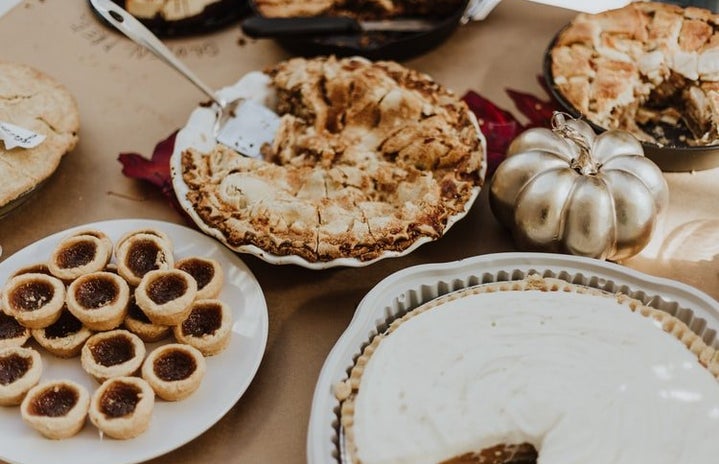November is here, which means one very important thing: the holidays are officially upon us. While the last two months of the year never fail to bring endless gifts and shopping, quality family time and overall seasonal cheer, they can also cause a lot of uncertainty and anxiety around food, especially for those who may struggle with body image, those who feel societal pressure to adopt a new diet ahead of the new year, or those whose families members tend to offer far too much unsolicited dietary advice at the Thanksgiving table. If these are traps you tend to fall into year after year, fear no more; I’ve got you covered with seven dietitian-backed pieces of advice to follow ahead of the most wonderful time of the year!
- Ditch the new year diet plans
-
Let’s make something clear right off the bat: diets do not work. I know that this statement is one that is surrounded by immense controversy — everyone and their mother seems to have an aunt who lost 40 pounds on Keto or a cousin who has dropped three pant sizes through Weight Watchers — but the reality is that diets with such restrictive regimens are not sustainable, which means that while their participants may temporarily enjoy a slimmer figure, they are nearly statistically guaranteed to put on all of that weight once again, and in most instances, gain even more.
My point? There’s no need to treat Thanksgiving and Christmas like figurative “last suppers,” where these days are your only opportunities to enjoy pumpkin pie and mashed potatoes and casseroles before months without any appetizing meals; this only sets us up for binges on holidays! If a new year diet isn’t imminent and these occasions are simply thought of as opportunities to spend time with loved ones and indulge in special treats, our odds of overeating and inevitably falling prey to a binge-restrict cycle are far less.
- don’t sweat one meal
-
On our first day back to fifth grade following Thanksgiving Break, one of my peers shared with our science class that she had gained five pounds from her family’s Thanksgiving dinner alone. For years, this comment stuck with me and lurked in the back of my mind at every holiday meal I tried to enjoy. How was it possible that one dinner could cause such a substantial change in weight? Was I, too, just one bread roll or an extra dessert from returning to school several pounds heavier?
To put it simply, this is far from how weight gain works. While the scale may read an exorbitantly high number immediately following a large meal, this is only because the food hasn’t passed through our systems yet — this process can take up to eight hours! — and because when we consume foods with a high amount of sodium, a quality that many holiday staples possess, our bodies temporarily retain excess fluid to help flush the salts. Regardless of how much turkey and pie she ate at the Thanksgiving table, if my fifth-grade classmate had weighed herself even just a few hours later, her scale most certainly would not have showed a five-pound increase in weight; such a drastic change as a result of one meal simply is not scientifically possible.
If you also have a fear of gaining weight from eating Thanksgiving dinner, rest assured that no one meal has that kind of power.
- diversify your plate
-
As a picky eater, I understand how challenging it can be to branch out beyond the traditional comfort foods we have grown to love, but it is important for myriad reasons to make at least somewhat of an effort to incorporate a variety of food groups and macronutrients at seasonal meals. The key here, however, is never to cut out any foods on your plate because you feel they are not sufficiently healthy; rather, allow yourself to enjoy all of your favorites, but make sure that you save room for nutritious additions like fruits, vegetables, and protein sources!
For example, if you’re like me and tend to load your Thanksgiving plate with all the carbs you can get your hands on, consider balancing your macronutrients by including a fat or protein as a side. If you feel that your meal is heavy in starchy or rich foods, lighten things up by adding a small side salad or a handful of grapes. Again, as always, resist any urge to deem a dish too unhealthy to earn a spot on your plate; dietitians consistently emphasize that the key to nutrition is to add rather than to subtract.
- Take it slow
-
It’s the evening of a long-awaited family Christmas party. All of your loved ones are gathered at tables in the dining room anxiously anticipating the cue to finally dive into each and every hand-crafted dish available. You hear the words“It’s time to eat!” and explode out of your seat, teeming with enthusiasm as you explore the buffet of ham and warm potatoes and macaroni and endless desserts. Your appetite grows by the second, you scoop out heaping dollops of everything you can fit onto your plate, and when you sit back down after assembling a tray that is filled to its maximum, you scarf down each and every bite. Then, without another thought, you jump in line and once again fill your plate, eating way more than what you thought was physically capable. Soon afterward, you feel disgustingly bloated and completely exhausted and are staunchly reminded that this is why you often resent the aftermath of holiday meals.
We’ve all been there. While the physical sensation of overconsumption can be deeply uncomfortable and even cause nausea or vomiting, the resulting mental state can often manage to be even more toxic, where our minds are plagued with deep-rooted feelings of guilt and embarrassment and anxiety. The key to never being in this position again on a holiday that is supposed to bring so much happiness and warmth? Take it slow.
I don’t want to speak to the hostility of your regular Thanksgiving or Christmas functions — perhaps if you don’t rush the dinner table in an aggressive fashion, there truly won’t be any food for you left — but I personally like to remind myself that there still will be more than enough for me to eat regardless of how much time I take in enjoying my meals; that’s how leftovers come to exist in the first place! When we place so much urgency behind our meals, we eat in such a way that not only makes digestion more difficult but also inhibits our ability to interpret hunger cues and make an accurate determination as to how hungry we actually are. Take your time between getting seconds and thirds and fourths, avoid feeling any obligation to fill your plate to the brim at every serving, and watch your holiday dining experiences improve exponentially!
- don’t conserve to splurge
-
Holiday weight gain may be one of the most feared experiences during the months of November and December — aside from perhaps a highly coveted gift getting lost in the mail — which means that the tendency to seek out methods of combatting this increase in weight, regardless of whether such methods possess dietetic merit, is only a natural reaction. Because it is so common to feel a substantial lack of control at Thanksgiving and Christmas meals or other family gatherings, we often see the adoption of a starve-and-binge approach in order to manage calories. For example, if you anticipate eating a 1,000 or 1,500 calorie meal at a family gathering later in the evening, you may reduce your consumption throughout the entirety of the morning and the afternoon to a mere 500 calories. As a result, you won’t exceed your maintenance calories for the day, and any weight gain is avoided, right? Wrong.
Not only is this strategy absolutely atrocious for your metabolism, but “saving” your calories throughout the day so that you can eat a substantial amount later can be a total recipe for disaster. When we have restricted for the majority of our day, our first instinct in the presence of food is to eat as much of it as we can get our hands on, and consequently, a meal for which we may have allotted 1,500 calories can turn into 2,000 or 2,500 in a hurry, especially since traditional holiday foods tend to have higher caloric values. Instead of falling into this trap, a far better approach is to maintain consistent eating habits throughout the day and maybe even consider having a snack at home before attending holiday functions; this way, if we aren’t ravenously hungry at mealtime, we can enjoy a greater sense of control at Thanksgiving or Christmas events.
- stay active
-
While exercise isn’t perhaps as directly related to nutrition as the above pieces of advice, physical activity has been proven to aid in digestion and metabolic processing, which can be extremely important after consuming copious amounts of food. We tend to think of movement exclusively as a trip to the gym or a lengthy run, but we can benefit from anything that gets our heart rate up even just slightly, whether that means a brisk walk around the neighborhood, ten minutes of gentle yoga and stretching or participation in a fun family sports game. If your family’s holiday celebrations are usually held in a colder region, you might even consider making a tradition of ice skating or a snowball fight after the big meal.
The idea here is to avoid remaining completely sedentary after indulging in holiday meals, but remember that exercise doesn’t have to be boring or overly strenuous –– moving your body in any way after eating is bound to help you feel your best both mentally and physically!
- ask if you’re still hungry
-
I consider myself to be a rather task-oriented person, meaning that when I start any sort of project or assignment, I am wholeheartedly committed to completing it, and I dedicate the entirety of my focus to that one task until I have sufficiently completed it. This personal quality often seems to translate into my instinctual eating habits, where any time I order a restaurant entrée or prepare myself a meal at home, my goal is to finish that portion of food, regardless of whether I’m completed famished, uncomfortably full, or somewhere in between. When I developed a passion for nutrition and started taking a more critical look at my dietary habits, this trend was one of the first problematic patterns I recognized: am I continuing to eat because I’m actually hungry, or is a clear plate just another arbitrary task that I feel obligated to complete?
If you, too, tend to struggle with differentiating between genuine hunger and an inclination to simply complete a task, you’re far from alone. My best advice? Take periodic breaks during your meal to assess your fullness, and only resume eating once you’re certain that your food consumption stems from a place of hunger rather than any other potential influence.
The holidays can most certainly be a challenging time for many when it comes to navigating the pressures of diet culture alongside potential food anxiety at mealtime, but hopefully with these tips in mind, the process can feel slightly less burdensome. Here’s to an abundant and healthy remainder of the year!


